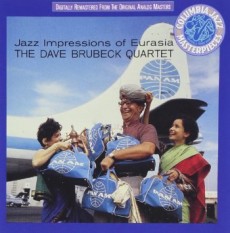
Daily Dose Of Jazz…
Dave Brubeck was born David Warren Brubeck on December 6, 1920 in Concord, California and grew up in Ione. His father, a cattle rancher, his mother Studied piano with intention to become a concert pianist, taught he son to play. He could not read music during these early lessons, attributing this difficulty to poor eyesight, but faked his way well enough that this deficiency went mostly unnoticed.
Brubeck entered the College of the Pacific studying veterinarian science but changed his major to music at the best of the head of zoology. Discovered that he could not read music he was almost expelled but his ability with counterpoint and harmony more than compensated.
In 1942, Brubeck was drafted into the U.S. Army, and serving in Europe played piano at a Red Cross show and was such a hit that he was spared from combat service and ordered to form a band. He created one of the U.S. armed forces’ first racially integrated bands, The Wolfpack. It was here that he met Paul Desmond in early ’44. He returned to college after discharge, completed his studies, worked with an octet and with an experimental trio with Cal Tjader and Ron Crotty, and often joined onstage by Desmond.
He recorded his first sessions in 1949 for Coronet Records, soon to become Fantasy Records owned by the Weiss Brothers. In 1951 he organized the Dave Brubeck Quartet with Paul Desmond on alto saxophone, taking up a long residency at San Francisco’s Black Hawk nightclub. During this period he recorded a series of albums and gained great popularity touring college campuses.
Dave signed with Fantasy Records, worked as an A&R man and brought in Gerry Mulligan, Chet Baker and Red Norvo. Discovering he only owned half interest in his own recording and not the label he moved to Columbia Records.
In 1959, the Dave Brubeck Quartet recorded Time Out, a seminal album that featured unusual time signatures that quickly went platinum and was the first jazz album to sell more than a million copies. A high point for the group was their 1963 live album At Carnegie Hall, arguably his greatest concert.
Over the next several decades Brubeck would record many albums, develop a jazz musical, The Real Ambassadors, working with Louis Armstrong, Lambert, Hendricks and Ross, and Carmen McRae, perform at the Monterey Jazz Festival, did a series of Jazz Impressions albums, and was the program director of all-jazz format WJZZ-FM radio.
Of his many honors pianist Dave was inducted into the California Hall of Fame, was honored with a Time Magazine cover that he felt should have gone to Duke Ellington, and received an honorary Doctor of Music degrees from the Eastman School of Music, Berklee College of Music and George Washington University.. He was honored by the Kennedy Center, was awarded the Miles Davis Award and Bruce Ricker and Clint Eastwood produced the documentary Dave Brubeck: In His Own Sweet Way.
Pianist and composer Dave Brubeck, considered to be one of the foremost exponents of cool jazz, passed away of heart failure, ironically, on his way to a cardiology appointment, on December 5, 2012, in Newark, Connecticut, one day before his 92nd birthday.
More Posts: piano
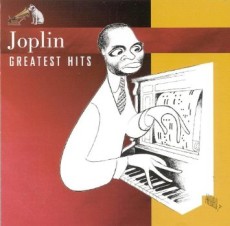
Daily Dose Of Jazz…
Scott Joplin was November 24, 1867 or 1868 in Northeast Texas into a musical family of railway laborers and developed his musical knowledge with the help of local teachers. Growing up in Texarkana, he formed a vocal quartet, and taught mandolin and guitar. During the late 1880s he left his job as a laborer with the railroad, and travelled around the Southern states as an itinerant musician.
By 1893 he was in Chicago, Illinois for the World’s Fair and played a major part in making ragtime a national craze by 1897. Joplin moved to Sedalia, Missouri in 1894, earned a living as a piano teacher and taught future ragtime composers Arthur Marshall, Scott Hayden and Brun Campbell. He began publishing music in 1895, and publication of his “Maple Leaf Rag” in 1899 brought him fame. This piece had a profound influence on subsequent writers of ragtime and brought the composer a steady income for life. Though he never reached this level of success again, he would frequently have financial problems, causing him to lose a be forever lost, the score to his first opera A Guest of Honor for non-payment of bills.
Joplin moved to St. Louis in 1901, continued composing and publishing music, and regularly performed in the St. Louis community. In 1907, a move to New York City had him searching for a producer for a new opera, Treemonisha, which, went beyond the limitations of his then famous music and was not well received when partially staged in 1915.
In 1916 he descended into dementia as a result of syphilis. He was admitted to a mental institution in January 1917, and died there three months later on April 1st at the age of 49. Scott Joplin death is widely considered to mark the end of ragtime as a mainstream music format, and in the next several years it evolved with other styles into stride, jazz and eventually big band swing. His music was rediscovered and returned to popularity in the early 1970s with the release of a million-selling album recorded by Joshua Rifkin. Several of his compositions including The Entertainer were featured in the Academy Award winning 1973 movie The Sting, and his opera Treemonisha was finally produced in full to wide acclaim in 1972. In 1976, Joplin was posthumously awarded a Pulitzer Prize. During his lifetime her composed 44 original ragtime pieces, one ragtime ballet and two operas.
More Posts: piano
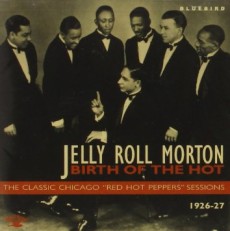
Daily Dose Of Jazz…
Jelly Roll Morton was born Ferdinand Joseph LaMothe on October 20, 1890 into a common-law creole of color family in the Faubourg Marigny neighborhood of downtown New Orleans, Louisiana. He started playing music as a child, showing early talent. After his parents separated, his mother married a man named Mouton and anglicizing it changed it to Morton.
At the age of fourteen, Morton began working as a piano player in a Storyville brothel, then known as a sporting house. In that atmosphere he often sang smutty lyrics and it was there he took the nickname “Jelly Roll”, which was African American slang for female genitalia. While working there, he was living with his religious, church-going great-grandmother; he had her convinced that he worked as a night watchman in a barrel factory. After Morton’s grandmother found out that he was playing jazz in a local brothel, she kicked him out of her house. However, Tony Jackson, also a pianist at brothels and an accomplished guitar player, was a major influence on his music.
Around 1904, Jelly Roll started touring in the American South, working with minstrel show, gambling and composing. He moved to Chicago in 1910 and New York City the following year where future stride greats James P. Johnson and Willie “The Lion” Smith caught his act, years before the blues were widely played in the North. His works Jelly Roll Blues, composed in 1915, has arguably become the first jazz song ever published. New Orleans Blues, Frog-I-More Rag, Animus Dance and King Porter Stomp followed as they were composed during this period. In 1917, he followed bandleader William Manuel Johnson Johnson’s sister Anita Gonzalez to California, where his tango The Crave, made a sensation in Hollywood. Returned to Chicago in 1923 to claim authorship of his recently published rag, “The Wolverines”, which had become a hit as “Wolverine Blues” in the Windy City. He released the first of his commercial recordings, first as piano rolls, then on record, both as a piano soloist and with various jazz bands.
In 1926, Morton succeeded in getting a contract to record for the largest and most prestigious company in the United States, Victor. This gave him a chance to bring a well-rehearsed band to play his arrangements. These recordings by Jelly Roll Morton & His Red Hot Peppers are regarded as classics of 1920s jazz. They featured Kid Ory, Omer Simeon, George Mitchell, Johnny St. Cyr, Barney Bigard, Johnny Dodds, Baby Dodds and Andrew Hilaire. And the group became one of the first acts to be booked on tour by MCA. Moving to New York City in 1928 he continued to compose and record for Victor with the aforementioned in addition to George Baquet, Albert Nicholas, Wilton Crawley, Russell Procope, Lorenzo Tio, Artie Shaw, Bubber Miley, Johnny Dunn, Henry “Red” Allen, Sidney Bechet,, Paul Barnes and Bud Freeman, Pops Foster, Paul Barbarin, Cozy Cole and Zutty Singleton.
During the Great Depression Morton lost his contract with Victor, struggled financially and took a job with a traveling burlesque show for steady income. In 1935, his 30-year-old composition King Porter Stomp arranged by Fletcher Henderson became Benny Goodman’s first hit and swing standard but Jelly Roll received no royalties from its recordings.
A move to Washington, DC saw him becoming the manager, piano player, master of ceremonies, bouncer and bartender of a bar located at 1211 U Street in the NW Black section of town called Shaw. Unable to make it a success due to the owner’s bad business decisions and being stabbed by a friend of the owner, Morton’s wife demanded they leave DC. Before his departure folklorist Alan Lomax invited him to record music and interviews at the Library of Congress, which ended after eight hours, though Lomax conducted longer interviews but only to notes without recording.
When Morton was stabbed and wounded, a nearby whites-only hospital refused to treat him, as the city had racially segregated facilities. Transported to a black hospital farther away it was several hours before being attended to and his recovery suffered, often he became short of breath. Worsening asthma sent him to a New York hospital for three months at one point and although he continued to suffer from respiratory problems when visiting Los Angeles, California with manuscripts of new tunes and arrangements, planning to form a new band and restart his career, pianist and composer Jelly Roll Morton passed away on July 10, 1941, after an eleven-day stay in Los Angeles County General Hospital. He was inducted into the Rock and Roll Hall of Fame, the Louisiana Hall of Fame and is a charter member of the Gennett Records Walk of Fame.
More Posts: piano
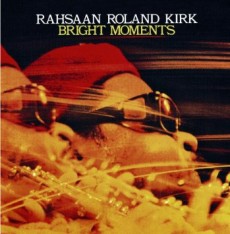
Daily Dose Of Jazz…
Rahsaan Roland Kirk was born Ronald Theodore Kirk on August 7, 1935 in Coumbus, Ohio and grew up in the neighborhood called Flytown. He felt compelled by a dream to transpose two letters in his first name to make Roland. He became blind at an early age as a result of poor medical treatment. In 1970 he added “Rahsaan” to his name after hearing it in a dream.
Rahsaan preferred to lead his own bands and rarely did he perform as a sideman, although he did record lead flute and solo on Soul Bossa Nova with arranger Quincy Jones in 1964, as well as drummer Roy Haynes and had notable stints with bassist Charles Mingus. His playing was generally rooted in soul jazz or hard bop but his knowledge of jazz gave him the ability to draw from ragtime to swing to free jazz. In additional to classical influences he borrowed elements from composers like Smokey Robinson and Burt Bacharach, Duke Ellington and John Coltrane.
His main instrument was the tenor saxophone and two obscure saxophones: the stritch, a straight alto sax lacking the instrument’s characteristic upturned bell and a manzello, a modified saxello soprano sax, with a larger, upturned bell. Kirk modified these instruments himself to accommodate his simultaneous playing technique. He also played flute, clarinet, harmonica, English horn, recorder and trumpet, as well as incorporating an interesting array of common items such as garden hose, alarm clocks and sirens.
At times Rahsaan would play a number of these horns at once, harmonizing with himself, or sustain a note for lengthy durations by using circular breathing or play the rare, seldom heard nose flute. Many of Kirk’s instruments were exotic or homemade, but even while playing two or three saxophones at once the music was intricate, powerful jazz with a strong feel for the blues. Politically outspoken, he would often talk about issues of the day in between songs at his concerts, such as Black history and the civil rights movement and lacing them with satire and humor. According to comedian Jay Leno, when he toured with him as his opening act, Kirk would introduce him by saying, “I want to introduce a young brother who knows the black experience and knows all about the white devils… Please welcome Jay Leno!”
In 1975, Kirk suffered a major stroke that led to partial paralysis of one side of his body. However, he continued to perform and record, modifying his instruments to enable him to play with one arm. He died from a second stroke on December 5, 1977 after performing in the Frangipani Room of the Indiana University Student Union in Bloomington, Indiana.
His influence went well beyond jazz to include such rock musicians as Jimi Hendrix, Ian Anderson of Jethro Tull, Eric Burdon and War, T.K. Kirk, Hope Clayburn, Jonny Greenwood and Ramon Lopez, all who idolized or paid tribute to, and David Jackson, George Braith and Dick Heckstall-Smith who took to playing multiple saxophones, and Steve Turre, Courtney Pine who utilizing his circular breathing during play. He left to us nearly four-dozen albums as a leader and another eleven with aforementioned Jones, Mingus and Haynes, and Tubby Hayes, Tommy Peltier, Jaki Byard and Les McCann.
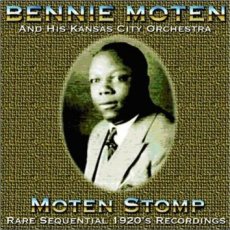
Daily Dose Of Jazz…
Bennie Moten was born on November 13, 1894 in Kansas City, Missouri. By the time he reached his mid-twenties he was leading the Kansas City Orchestra that was the most important of the itinerant, blues-based orchestras active in the Midwest at the time. The band helped develop the riffing style that would come to define many of the 1930s Big Bands.
Moten first recorded with Okeh Records in 1923 influenced by New Orleans and ragtime. His Victor Records sessions had a more sophisticated sound similar to Fletcher Henderson but featured a hard stomp popular to Kansas City.
By 1928 Bennie’s piano was showing some Boogie Woogie influences, but the real revolution came in 1929 when he recruited Count Basie, Walter Page and Oran “Hot Lips” Page. Walter Page’s walking bass lines gave the music an entirely new feel compared to the 2/4 tuba, colored by Basie’s understated, syncopated piano fills.
Their final session comprised of 10 recordings made in 1932 were made during a time when the band was suffering significant financial hardship but had added Ben Webster and Jimmy Rushing as their primary vocalist. These recordings showed the early stages of what became known as the “Basie Sound” some four years before Basie would record under his own name.
Pianist and bandleader Bennie Moten passed away after an unsuccessful tonsillectomy on April 2, 1935.
More Posts: piano


